Collection of materials relating to neuro-ophthalmology as part of the Neuro-Ophthalmology Virtual Education Library.
NOVEL: https://novel.utah.edu/
TO
Filters: Collection: "ehsl_novel_novel"
| Title | Creator | Description | Subject | ||
|---|---|---|---|---|---|
| 1 |
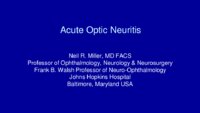 |
Acute Optic Neuritis | Neil R. Miller, MD, FACS | Overview of acute optic neuritis. | Optic Neuritis |
| 2 |
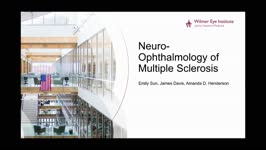 |
Neuro-Ophthalmology of Multiple Sclerosis | Emily Sun, Medical Student; Amanda Henderson, MD | Multiple Sclerosis (MS) is the most common neurological disease in young people with an average age of onset between 15 and 35 years old. MS is an autoimmune inflammatory condition that causes demyelinating lesions in the CNS. The diagnosis is clinical, but MRI is typically used to support the diagn... | Multiple Sclerosis; Optic Neuritis; Uveitis; Internuclear Ophthalmoplegia; Nystagmus; Steroids; Demyelinating; Autoimmune |
| 3 |
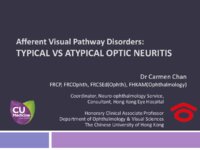 |
Afferent Visual Pathway Disorders: Typical vs Atypical Optic Neuritis | Carmen Chan, FRCP, FRCOphth, FRCSEd(Ophth), FHKAM(Ophthalmology) | Discussion of typical vs atypical optic neuritis. | Optic Neuritis |
| 4 |
 |
Animated Lessons on the Neurology of Eye Movements and Pupillary Disorders | Dario Beltran, MD; Douglas Woo, MD; Elliot Frohman, MD, PhD; Steven L. Galetta, MD; Lewis E. Calver, MS; Kim Hoggatt Krumwiede, MA | This interactive training guide correlates clinical eye exams with lesion localization using illustrations, animations, and MRI's to enhance the learning of various common neuro-ophthalmologic lesions that are found in patients with Multiple Sclerosis (MS), stroke, tumor, or infection. Neurologists,... | Pupil Abnormalities; Ocular Movement Abnormalities; Diplopia |
| 5 |
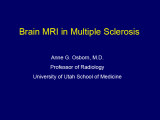 |
Brain MRI in Multiple Sclerosis (Guest Lecture) | Anne G. Osborn, MD | The patient is a 25 year old woman who was in excellent health until 4 days prior to admission when she noted blurred vision and horizontal double vision on lateral gaze to right and left. Past History: Negative for strabismus as a child. No previous episodes of transient neurological symptoms. Fami... | Bilateral Internuclear Ophthalmoplegia; Abducting Nystagmus; Normal Convergence; Gaze Evoked Upbeat Nystagmus; Gaze Evoked Downbeat Nystagmus; Saccadic Dysmetria; Multiple Sclerosis; Horizontal Saccadic Dysmetria |
| 6 |
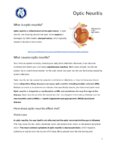 |
Optic Neuritis | NANOS | In the most common form of optic neuritis, the optic nerve has been attacked by the body's overactive immune system and results in decreased vision. | Optic Neuritis; Patient Brochure |
| 7 |
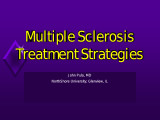 |
Multiple Sclerosis Treatment Strategies | John Pula, MD | Slideshow exploring current treatment of multiple sclerosis. | Multiple Sclerosis; Multiple Sclerosis Treatment |
| 8 |
 |
Examination of Lymph Nodes | John D. Ng, MD, MS, FACS | Demonstration of lymph node examination. | Exam; Lymph Nodes |
| 9 |
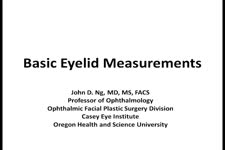 |
Basic Eyelid Measurements | John D. Ng, MD, MS, FACS | Demonstration of basic eyelid measurements. | Eyelid |
| 10 |
 |
Other Trigeminal Autonomic Cephalalgias (TACs) | Jihad Yaqoob Ali Al Kharbooshi; Tommy Lik Hang Chan; J. Alexander Fraser | In this narrated slideshow, we review the pathophysiology, epidemiology, differential diagnosis, diagnostic criteria, subtypes, and management of the other trigeminal autonomic cephalalgias (cluster headache and the SUNHA syndromes). It is a companion to our earlier slideshow, "Trigeminal autonomic ... | Indomethacin; SUNA; SUNCT; SUNHA; TAC; Trigeminal Autonomic Cephalalgia |
| 11 |
 |
NANOS Illustrated Curriculum Section D Introduction | Meagan D. Seay, DO; Victoria S. Pelak, MD | Introduction video to the resources available in Section D of the NANOS Illustrated Curriculum. | Lesions, Afferent Visual Pathway; Disorders, Afferent Visual Pathway; Pupillary Anatomy; Disorders, Pupillary Function; Lesions, Efferent Visual Pathway; Ocular Motility; Abnormal Eye Movements; Eyelids; Abnormal Facial Movements |
| 12 |
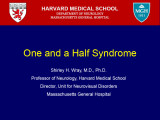 |
One and a Half Syndrome | Shirley H. Wray, MD, PhD, FRCP | This 44 year old woman presented in 1973 with an acute attack of optic neuritis in the right eye that fully recovered after a course of ACTH therapy. In 1991, 18 years later, she developed unsteadiness of gait, "walking like a chicken", stiff legs that jerked spontaneously in bed at night, and numbn... | Unilateral Internuclear Ophthalmoplegia; Unilateral Horizontal Gaze Palsy; Upbeat Nystagmus on Upgaze; Convergence Normal; Fisher's One-and-a-Half Syndrome; Uhthoff's Symptom; Multiple Sclerosis; Unilateral Horizontal Gaze Palsy Demyelination; Gaze Evoked Upbeat Nystagmus; Abducting Nystagmus |
| 13 |
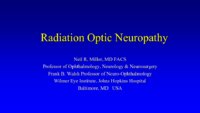 |
Radiation Optic Neuropathy | Neil R. Miller, MD, FACS | Overview of Radiation Optic Neuropathy (RON). | Radiation Optic Neuropathy; RON |
| 14 |
 |
Dual Visual Field Defect (Quadrantanopia and Central Scotoma) Unmasks the Hidden Brain Lesion in a Patient with Non-arteritic Ischemic Optic Neuropathy | A. Mohan Kannam; B. Rajat Kapoor; C. Ramesh Kekunnaya, FRCS; Virender Sachdeva, MS, DNB | This submission is an interesting case that highlights the co-existence of two different visual field defects in the same patient presenting to us with clinical picture of non arteritic ischemic optic neuropathy. The correct interpretation of the visual field defects led to the appropriate localizat... | Hemianopia; Central Field Defect; Non-Arteritic Ischemic Optic Neuropathy; Ischemic Infarct |
| 15 |
 |
Anatomic and Physiologic Basis for Gaze Stability | Ariel Winnick and Meagan Seay, DO | Diagram describing the anatomic and physiologic basis of gaze stability. | Gaze Stability |
| 16 |
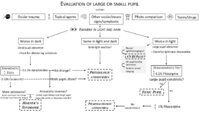 |
Pupil Evaluation Flowchart | Ariel Winnick; Eric Caskey, MD; Meagan Seay, DO | Flow chart outlining the evaluation of large or small pupils. | Pupil Evaluation |
| 17 |
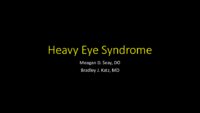 |
Heavy Eye Syndrome | Meagan D. Seay, DO; Bradley J. Katz, MD | A brief overview of heavy eye syndrome. | Heavy Eye Syndrome |
| 18 |
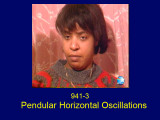 |
Pendular Oscillations | Shirley H. Wray, MD, PhD, FRCP | This 37 year old woman has had progressive multiple sclerosis (MS) affecting the cerebellum and brainstem for 6 years. Neurological examination: Titubation Dysarthria Incoordination of the extremities Ataxic gait Spastic paraparesis with generalized hyperreflexia and extensor plantar responses. Neur... | Pendular Horizontal Oscillations; Left Beating Nystagmus; Obtrusive Saccades; Bilateral Gaze Evoked Nystagmus; Saccadic Dysmetria; Oscillopsia; Titubation; Ataxia; Multiple Sclerosis; Primary Position Horizontal Nystagmus; Gaze Evoked Horizontal Nystagmus; Horizontal Saccadic Dysmetria |
| 19 |
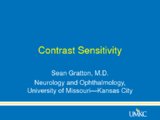 |
Contrast Sensitivity | Sean Gratton, MD | Explanation of contrast sensitivity. | Contrast Sensitivity |
| 20 |
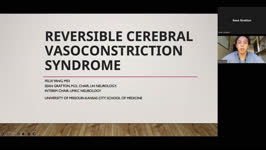 |
Reversible Cerebral Vasoconstriction Syndrome (RCVS) | Felix Yang; Sean Gratton | This is a narrated powerpoint that reviews Reversible Cerebral Vasoconstriction syndrome. It discusses the diagnostic basics and evaluation and management. It compares RCVS to Posterior Reversible Encephalopathy Syndrome (PRES). | Primary Angiitis of the Central Nervous System; Reversible Cerebral Vasoconstriction Syndrome; Subarachnoid Hemorrhage; Thunderclap Headache |
| 21 |
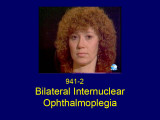 |
Bilateral Internuclear Ophthalmoplegia | Shirley H. Wray, MD, PhD, FRCP | This patient was seen at the Yale Eye Center at the age of 37. She had a long history of multiple sclerosis. At age 22, she had an acute attack of optic neuritis in the left eye which recovered fully within three weeks. Some months later she had a recurrent episode in the same eye, which also recove... | Bilateral Internuclear Ophthalmoplegia; Pendular Horizontal Oscillations; Lid Nystagmus; Upbeat Nystagmus; Botulinum Toxin Therapy; Multiple Sclerosis; Horizontal Pendular Nystagmus; Gaze Evoked Upbeat Nystagmus; Abducting Nystagmus |
| 22 |
 |
Myelin Oligodendrocyte Glycoprotein Antibody Associated Disease (MOGAD) Revisited | Zahir Sheikh; Michael Gilhooley | The purpose of this presentation is to review the varied clinical manifestations of MOGAD for the neurology and neuro-ophthalmology providers. | Demyelinating; MOG; MOGAD; Myelin |
| 23 |
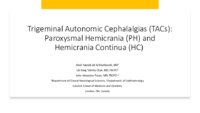 |
Trigeminal autonomic cephalalgias (TACs): Paroxysmal hemicrania (PH) and hemicrania continua (HC) | Jihad Yaqoob Ali Al Kharbooshi; Tommy Lik Hang Chan; J. Alexander Fraser | In this narrated slideshow, we describe the pathophysiology, epidemiology, diagnostic criteria, subtypes, workup, and management of hemicrania continua (HC) and paroxysmal hemicrania (PH). | Hemicrania Continua; Paroxysmal Hemicrania; TAC, Trigeminal Autonomic Cephalalgia |
| 24 |
 |
NExT Introduction | Sachin Kedar, MD, Editor-in-Chief | Transcript of video introduction to the NExT curriculum collection. | NANOS Examination Techniques |
| 25 |
 |
Macular Edema | Stephanie Chau Nguyen; James Brian Davis; Amanda Dean Henderson | Macular edema can result from pathologic extravasation of fluid through blood vessels in the macular region. This can be a feature of heritable diseases like dominantly inherited cystoid macular edema or acquired causes such as diabetic retinopathy, hypertensive retinopathy, retinal vein occlusions,... | Anti-VEGF; Diabetes; DME; Macular Edema; OCT |
